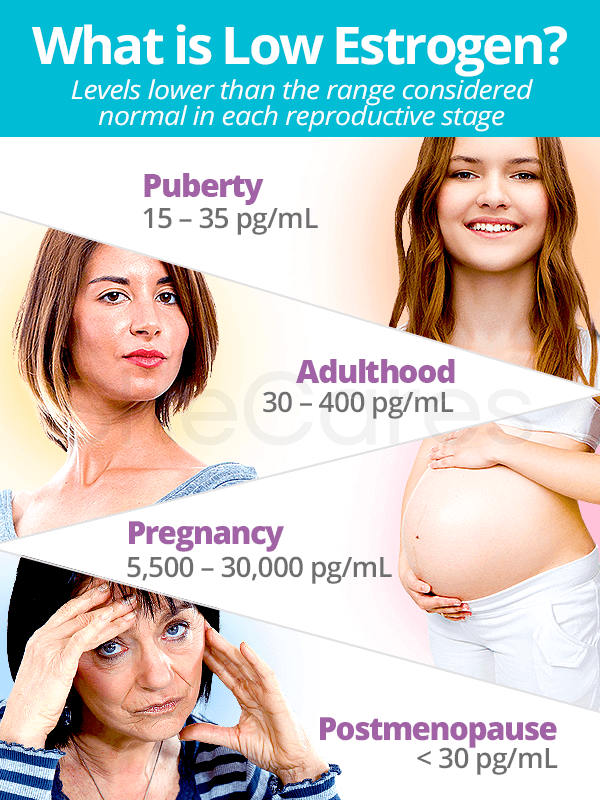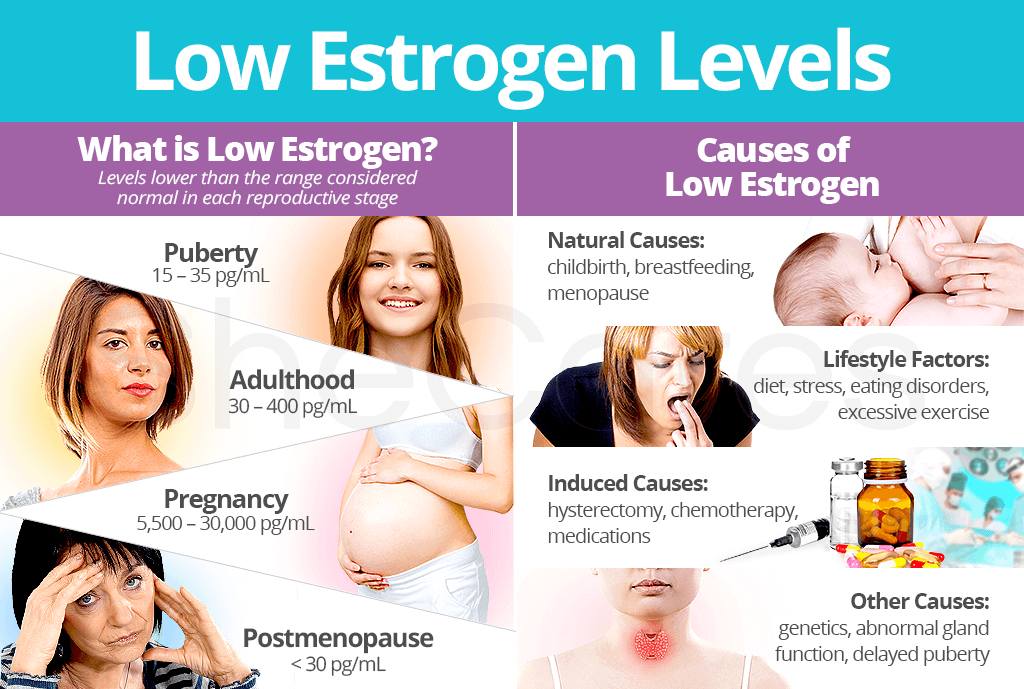It is natural for estrogen to fluctuate for women as it guides menstruation on a monthly basis. However, what generates issues is when estrogen levels are excessively lower than normal, causing many unwanted symptoms.
Continue reading to learn about low estrogen levels and what can cause unnatural fluctuations, including hormonal and lifestyle-related triggers.
About Low Estrogen Levels

During the menstrual cycle, estrogen steadily increases during the follicular phase. A spike in estrogen triggers ovulation, where an egg is released from a matured follicle. Afterwards, estrogen levels decline until the next menses.
In adulthood, it is normal for monthly estrogen levels to span from 30 - 400 pg/mL, depending on age and stage in the menstrual cycle. However, most women will experience abnormal drops in estrogen sometime during their lifetime, and these drops can be caused by a variety of factors.
Causes of Low Estrogen Levels
The causes of low estrogen levels can be divided into four categories: natural causes, lifestyle factors, induced causes, and other causes.
Continue reading to learn more about the origins of estrogen imbalance to improve symptoms and finally reach a state of complete health.
Natural Causes of Low Estrogen Levels

During Adulthood (20s to 40s)
Recall that estrogen fluctuates on a monthly basis within the menstrual cycle. However, low estrogen in women naturally occurs during childbirth and breastfeeding.
When a woman is pregnant, the placenta produces the majority of estrogen - estriol - starting around the ninth week of pregnancy until full term. After delivery of the placenta, estrogen levels drastically decrease within the following 24 to 48 hours.
In over half of women, these levels are so low that they resemble those of menopausal women. Depending on the woman, estrogen levels may remain low for several months after childbirth, especially if breastfeeding.
Breastfeeding poses a time when estrogen levels are usually low due to the causal relationship between prolactin levels and the absence of ovarian activity. Blood levels of prolactin will remain high, and in this way, suppressed estrogen levels can act as a form of birth control for many women.
During these times, low estrogen symptoms may ensue because endocrine and reproductive system health is affected. Symptoms include migraines, irritability, decreased libido, and more.
During Perimenopause and After Menopause (40s on up)
As eggs are expended throughout the years, there is a corresponding decline in the secretion of estrogen. This continues until menstruation ceases, and postmenopause begins.
This decline in estrogen levels is predominantly what causes the host of symptoms women experience, including night sweats, vaginal dryness, mental fogginess, hot flashes, and more.
For a needed hormonal boost, postmenopausal women may choose to pursue HRT (with risks involved) or supplement with estrogen products (pills, creams, patches, and gels). Natural treatments in the form of herbal supplements that nourish hormonal glands are also viable options.
Lifestyle Factors that Cause Low Estrogen Levels
Also, there are a variety of lifestyle factors that can cause low estrogen levels. Some of them include, but are not limited to, the following:
Diet. Fatty foods have a very strong influence on hormonal activity in the body. It has been found that with high-fat diets, estrogen levels increase. However, the opposite is also true; low-fat diets will cause estrogen levels to drop significantly in a short amount of time.
Stress. Excessive stress can disrupt hypothalamic function, which stimulates and regulates endocrine activities, causing an estrogen deficiency. Moreover, research has proven that days with higher perceived levels of stress are characterized by lower levels of estradiol in women's saliva.
Eating disorders. Eating disorders, such as anorexia nervosa, and extreme dieting can lead to estrogen deficiency. Low female body weight can prompt the body to stop producing estrogen, resulting in amenorrhea - a lack of menstruation - and further medical concerns.
Extreme exercise. Stress- and exercise-induced amenorrhea from insufficient body fat content causes the body to believe it is in a “starvation state.” This shuts down bodily operations not deemed necessary for survival, such as those of the reproductive system.
Induced Causes of Low Estrogen Levels
Various procedures and treatments can cause lower estrogen levels, including hysterectomies, radiation therapies, and certain medications.
Hysterectomies involve the surgical removal of the uterus, sometimes along with other reproductive organs, like the cervix or ovaries. Women who have their uterus and ovaries removed - as part of a hysterectomy with bilateral salpingo-oophorectomy - can suffer from decreased estrogen levels as the procedure halts ovarian hormone production.
Following a total or partial hysterectomy in which the uterus is removed with or without the cervix can also force a woman to enter surgically-induced menopause sooner than she normally would. Typically, the ovaries stop working within one to three years afterwards as blood flow to them ceases.
Also, loss of ovarian function from chemotherapy or radiation therapy can be permanent or temporary. Functions may stop as soon as two to three weeks into treatment. It depends upon the type of chemotherapy received and whether or not radiation was utilized on the ovaries.
Moreover, use of exogenous hormones and medications for other medical conditions can also trigger low estrogen levels. Drugs such as rifampicin, barbiturates, warfarin, primidone, and more decrease estrogen levels by enhancing the hormone's metabolism in the liver.
Other Causes for Low Estrogen Levels
Moreover, the following conditions can each prompt low levels of estrogen in women:
Congenital conditions. Genetic predispositions, such as Turner syndrome, estrogen insensitivity syndrome, and aromatase deficiency, can all cause a woman to have lower estrogen levels.
Abnormal gland function. Thyroid disorders and pituitary gland diseases have both been found to induce amenorrhea and offset hormones that aid in the secretion of estrogen.
Delayed puberty. Delayed pubertal development can provoke a variety of health conditions, improper ovarian development being one of them.
Overall, there are a range of natural, induced, and other causes that can provoke low estrogen levels throughout a woman's reproductive life.
Careful vigilance of hormone levels is important before estrogen deficiency develops. Continue reading to learn more about the signs and symptoms of low estrogen in order to catch the hormonal imbalance quicker.
Sources
- American Academy of Pediatrics and Pediatric Endocrine Society. (2014). Delayed Puberty for Girls: A Guide for Families. Retrieved August 18, 2017, from https://www.pedsendo.org/assets/patients_families/EdMat/Delayed%20Puberty%20Girls.pdf
- Birrittier, C. (2005). What Every Woman Should Know about Fertility and Her Biological Clock. New Jersey: New Page Books. Available from Google Books.
- Chao, S. (1987). The effect of lactation on ovulation and fertility. Clinics in Perinatology, 14(1), 39-50. Retrieved August 15, 2017, from https://www.ncbi.nlm.nih.gov/pubmed/3549114
- Fisher, E. (2015). Understanding Your Fertility while Breastfeeding. Retrieved August 15, 2017, from https://breastfeedingusa.org/content/article/understanding-your-fertility-while-breastfeeding
- Harvard Health Publishing. (2006). What are bioidentical hormones? Retrieved August 15, 2017, from https://www.health.harvard.edu/womens-health/what-are-bioidentical-hormones
- Khattar, D. et al. (2015). Correlating Estrogen Levels and Cognitive Functions in Regularly Menstruating Females of Reproductive Age Group and Post Menopausal Women of North India. Journal of Family and Reproductive Health, 9(2), 83-88. Retrieved August 29, 2017, from https://www.ncbi.nlm.nih.gov/pmc/articles/PMC4500819/
- Knight, J. (2016). The Complete Guide to Fertility Awareness. UK: Routledge. Available from Google Books.
- McNeilly, A.S. (1979). Effects of lactation on fertility. British Medical Bulletin, 35(2), 151-154. Retrieved August 15, 2017, from https://www.ncbi.nlm.nih.gov/pubmed/387162
- National Institutes of Health. (2016). What People With Anorexia Nervosa Need to Know About Osteoporosis. Retrieved August 16, 2017, from https://www.niams.nih.gov/Health_Info/Bone/Osteoporosis/Conditions_Behaviors/anorexia_nervosa.asp
- National Women's Health Resource Center, Inc. (2017). Estrogen. Retrieved July 11, 2017, from http://www.healthywomen.org/condition/estrogen
- The Physicians Committee. (n.d.). Fat and Hormonal Effects. Retrieved August 17, 2017, from https://www.pcrm.org/health/cancer-resources/diet-cancer/nutrition/fat-and-hormonal-effects
- Roney, J.R. & Simmons, Z.L. (2014). Elevated Psychological Stress Predicts Reduced Estradiol Concentrations in Young Women. Adaptive Human Behavior and Physiology, 1(1), 30-40. Retrieved August 17, 2017, from https://link.springer.com/article/10.1007%2Fs40750-014-0004-2
- University of Southern California. (2009). 5 Things You Need to Know About Exercise-Induced Amenorrhea. Retrieved August 16, 2017, from http://uscfertility.org/5-things-need-know-exercise-induced-amenorrhea/



